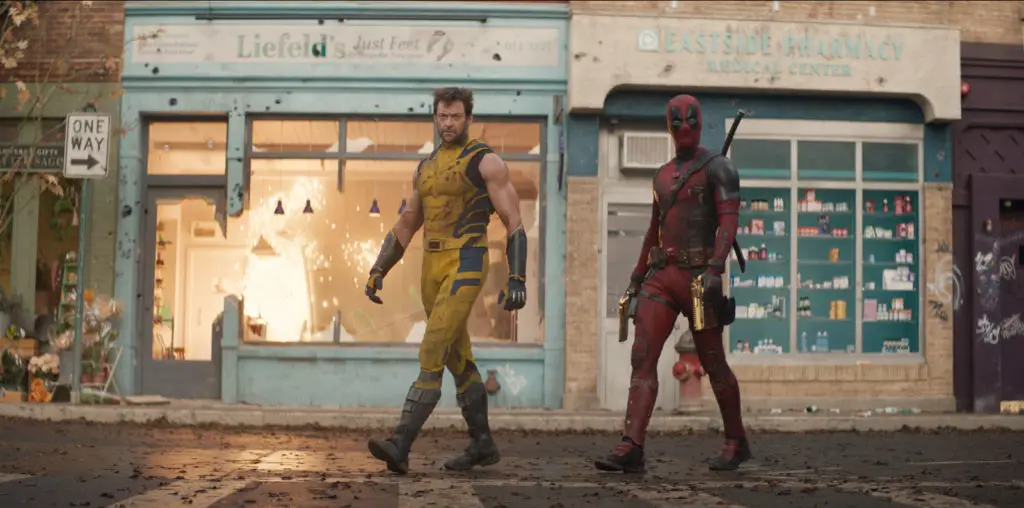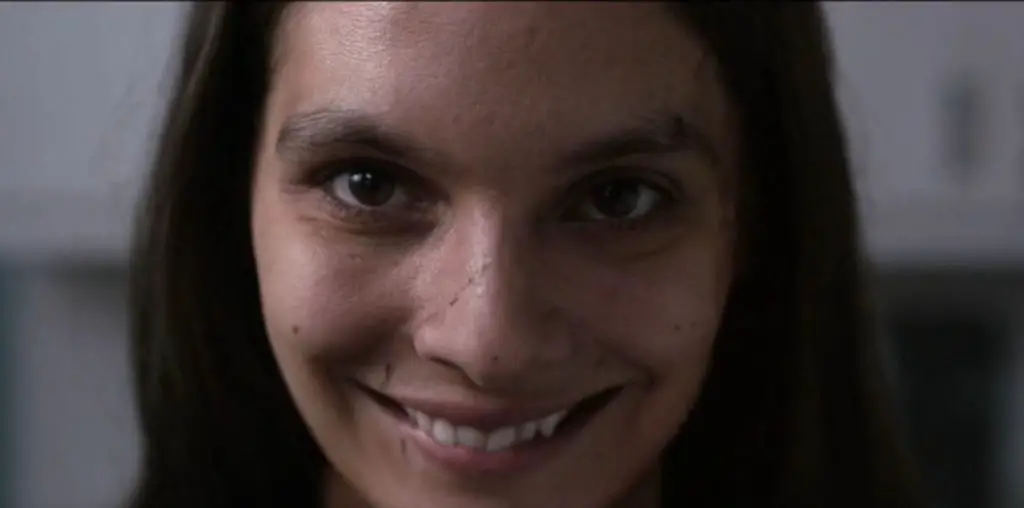
Mike Lyddon is an award-winning guerrilla filmmaker of multiple talents: director, producer, writer, editor, cinematographer, make-up effects artist, sound man. Yet in a world where filmmakers try to keep themselves in a solo spotlight, Lyddon has worked in collaboration with like-minded artists to pool creative influences.
Originally from California, Lyddon actually first attracted attention after moving to New Orleans in 1990 when he teamed with Jeff Turick on the experimental short “Warm and Bright,” which won a second place award at the Houston International Film Festival. Lyddon and Turick next collaborated on “Cut Up,” an intriguingly stylish feature about a traumatized detective-turned-police photographer who resumes his investigating habits when a grisly crime spree takes root. Filmed in 16mm over a year-and-a-half, “Cut Up” enjoyed international distribution in 1995 but strangely did not challenge US audiences until a few weeks ago when it had a home video debut via Sub Rosa Studios.
Lyddon followed “Cut Up” by pairing with Karl DeMolay and Will Frank on what is perhaps one of the most astonishing productions ever captured on film: “Zombie! Vs. Mardi Gras.” Filmed in black-and-white 8mm on a teeny $5,000 budget, this parody of horror films and the French Quarter hedonism provides an extraordinary skein of absurdist humor–including subtitled parodies of Godard, wacky sight-gags including a blind zombie with a seeing eye dog, and the appearance of the Renaissance astronomer Galileo as a zombie hunter–along with on-the-street filming of the wackiness of the Mardi Gras celebrations (including an extraordinary montage of happy young ladies flashing their breasts with seemingly little coercion). “Zombie! Vs. Mardi Gras” inspires no middle ground: either it is loved (screenings at the New York Underground Film Festival and Light+Screen Film Festival rolled with laughter and applause) or loathed (it has been dubbed the worst film ever made by several media outlets, including Newsday, the Amazing World of Cult Movies and the Phantom of the Movies’ Videoscope Magazine).
Lyddon, who has since left the craziness of New Orleans for the sanity of Bellingham, Washington, is now directing his first solo feature, a sci-fi comedy titled “Night For Nixie.” Film Threat caught up with Lyddon to discuss the collaborative efforts that went into his films.
[ You’ve co-directed two films with Jeff Turick and you co-directed “Zombie! Vs. Mardi Gras” with Karl DeMolay and Will Frank. What are the benefits and problems that arise in sharing the directing duties? ] ^ With Jeff on “Cut Up,” we were primarily in creative sync, which allowed us to move very fast. We wrote the script in five weeks and gathered cast and crew rather quickly. On the set we traded direction of scenes, and I was handling the special make up effects as well, so co-directing was crucial for the film. With “Zombie! Vs. Mardi Gras”, considering the other creators (although immensely creatively talented) were relative novices to film production, I assumed a lot of the directing/camera work, which proved to be very trying at times. All I can say is the film was finished, it’s pretty damn funny (albeit crude), and I loved that Super 8 black and white look!
[ You began your film career in New Orleans. What is the state of indie filmmaking in that location? Did you have problems in recruiting the right level of acting and technical support for your New Orleans films? ] ^ I have been out of N.O. for four years now, so I really don’t know the state of filmmaking there today. But when we did “Cut Up,” the support was definitely there. Kim Carbo of the Louisiana Film Commission helped us get things together, and Elizabeth Deluna of Shot in LA magazine was also very helpful with press. For crew and actors, we simply placed classifieds and spoke to people we knew. Many of the actors were theater based, which worked well. We had great crew people including DP Charles Bush, Lighting designer/gaffer Phil Beard, Prod manager Suzie K and many others who kicked a*s and made “Cut Up” look much more polished and expensive than the actual budget.
[ You were able to secure foreign distribution for your first feature rather quickly. What was your secret in getting the film into international markets? ] ^ We got “Cut Up” into a few festivals and immediately started contacting distributors. The first one interested was Four Corner Entertainment, which snagged the film for foreign. They didn’t do a hell of a lot with it, though–five territories in 1.5 years, but the sales we had were very good.
[ Although “Cut Up” was picked up immediately for distribution outside of the US, the film was not theatrically released in the US and it took five years before the film gained a home video pick-up. How do you explain the instant interest outside the US and the delayed reaction at home? ] ^ We screwed up. Two weeks after we signed with Four Corners, Arrow Films called and said they wanted “Cut Up” for both domestic and foreign! F**K! They were only interested if they could get both, so we got f****d. While in foreign, its hard to sell domestic because many companies want both or neither, so timing does have a lot to do with it.
[ What is the genesis of “Zombie! vs. Mardi Gras”? What magical influences came together to build the foundation of this extraordinary film? ] ^ Predominately a love for psychotronic culture: Corman, Jean-Luc Godard, Robert Anton Wilson, free masons, UFOs, Mardi Gras satire, sick puppetry, porn, cockroaches, pagan rituals, psychoactive drugs…..I could go on and on! The feel and look of the film revolves mainly around paying homage to Roger Corman and french filmmaker Jean-Luc Godard (do a career comparison, you’ll find remarkable similarities).
[ What was the shooting schedule for “Zombie! vs. Mardi Gras”? And what challenges came up by shooting the film in the midst of the mass-hedonism of Mardi Gras? ] ^ Shooting was pretty loose, over about 1.5 years and two different Mardi Gras festivities. We just filmed when we had money, which was kind of rare. Strangely, filming on Bourbon Street amidst wall to wall drunkards was fairly easy (but f*****g exhausting). We were able to move about and get shots rather quickly, as well as ask people if they’d be in a scene (usually to get attacked by Zombie!), and that went very well! And yes, I’ve never filmed so many breast shots in my life, but I wouldn’t mind beating that record!
[ Yes, those breasts were quite inspiring. But perhaps the most inspired sequence in “Zombie! vs. Mardi Gras” was the appearance of Galileo in purgatory being assigned to hunt down the zombie. How in the world did Galileo turn up in a New Orleans-based zombie comedy? ] ^ As you recall, the Pope pardoned Galileo several years ago…so we figured, “Hey, lets get Galileo in as a main character, who needs to kill the zombie before he’s totally pardoned!” The actor did a decent job looking like Galileo but we had to bring in another guy to overdub his voice, which worked out great–not to mention Rusty Jackson (also in “Cut Up”) as the snide Angel sent to give G-man the news.
[ “Zombie! vs. Mardi Gras” has been barbecued by some critics as being the worst film ever made. How does it feel to be among the creators of a film which some critics feel represents the lowest nadir of celluloid art? ] ^ Ah, well we deal with morons every day, and this is no exception. Some lame jerk-off actually complained about the end credit sequence where Zombie! runs slow motion into the arms of a beautiful girl in a lovely green field. He couldn’t believe the evil Zombie! got the girl at the end of the film?!? Good God, what an idiot…which proves film critics are usually filmmaker wannabes who lack both the intellectual and physical fortitude to make a film, so they wallow in uneducated opinions about other people’s work. Pretty sad, really. Another loser from Videoscope Magazine used an entire page to rant about how bad the film is, and in reality people who read the review were more intrigued about the film afterwards. Ha!
“Zombie! Vs. Mardi Gras” is cinema of the absurd, it works along a line of abstract thought and humor, and is definitely not your typical plot oriented film…BUT…If you are knowledgeable in cinema history and possess a brain, you will catch onto the film’s cryptic sensibilities.
[ Tell us about your new film “Night for Nixie.” What can we expect from this effort? ] ^ Yes, finally solo! I wrote, directed, produced and edited this one, which is going to be a doozy. It is scheduled for film festival release in two months, so please check out Reel Progress for updates as well as pics and vid clips from “Cut Up” and “Zombie! Vs. Mardi Gras.”
[ What advice would you give to aspiring filmmakers seeking a foot in the proverbial movie industry door? ] ^ Don’t put your foot in the proverbial door…it’s horseshit. Do your own thing, gather your own independent alliances and make films any way you can. Don’t jump on bandwagons, a la “Blair Witch Number 50″…just do your own thing, tell your own stories. You may be the only one who likes it, but who are you creating it for? The answer should be “yourself.” If people like it, fine…if they don’t, then that’s their problem!
“Cut Up” and “Zombie! Vs. Mardi Gras” are available on home video courtesy Sub Rosa Studios. “Zombie! Vs. Mardi Gras” can be seen in RealVideo on The Sync web site. E-mail: Mike Lyddon.
Check out FILMTHREAT.com’s INTERVIEW ARCHIVES and read hundreds of fascinating in-depth interviews with directors, filmmakers, actors and celebrities from the world of film!

